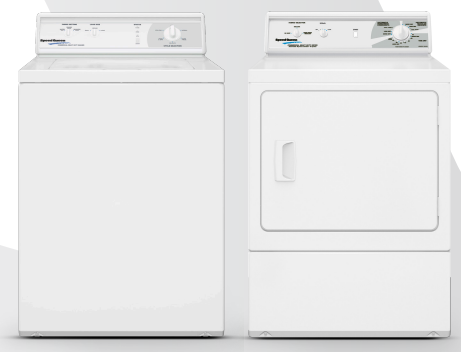
Your New Washer is designed to cater for all degrees of soiling. We recommend selecting wash times to suit your soiling level if possible. Use high-quality detergents, pre-mix in a container of hot water thus allowing the ingredients to activate before adding them to the machine. Using too much detergent can result in excess foam. It is recommended to use less than the amount of detergent recommended by the Detergent Manufacturer, as these machines have modern high efficiency wash actions – Liquid Detergents dilute most effectively in your wash water potentially giving better results.
Always separate dark colours from light colours. Towels should be washed separately
from other fabrics to reduce the risk of cross-contamination between materials.
If possible, do not wash heavily soiled items with lightly soiled ones.
Detergents, hand soap, or special pretreat products can
effectively prevent stains. Soaking before the wash cycle will improve cleaning results. Use a warm water presoak for oily soiled items and a cold water presoak for protein stains. Generally, soak periods of up to 60 minutes are sufficient for most loads.
For a good washing action. Too many clothes in the wash tub can result in poor cleaning, linting or wrinkling. When using a top-loading washer, place dry, unfolded clothes loosely in the tub to the top row of holes for a full load. In addition, use the correct level of water. Adjust the water level to each load so it visibly covers the load. Too little water can cause fabric to fabric wear
The type of detergent used may also affect the cleaning performance. Generally, granular detergents are recommended for hard water conditions and loads containing mud or clay types of soils. (ALWAYS ADD CLOTHES AFTER DETERGENT) Liquid detergents dissolve better in cold water and work well on greasy/oily stains. If cleaning results are not as expected, try different types or brands.
Detergent removes soil and lint and prevents it from re-depositing on the wash load. Manufacturers’ recommendations on the packaging are for average conditions, and actual dosage levels will vary from household to household. If the clothes are heavily soiled (treat the stains before the wash), if the load is extra large, or if the water is hard, more than the recommended dosage may be required. Conversely, if the water is extremely soft or only small loads are being washed, less than the recommended dosage will be required, preventing residue from being trapped in the fibres. And collecting between the inner and outer wash tubs.
The energy from the water temperature not only affects the removal of soils but also the chemical energy (detergent) added to the load. As the water temperature increases, chemical reactions (the detergent’s efficiency and other additives’ efficiency) proceed at a greater speed. The speed doubles with each 7-degree Celsius rise in temperature.
Select the correct cycle to allow dispersion at the correct cycle time. And clean the dispenser cup at the end of the wash. NB: Detergent and Fabric Conditioner may combine to form a slimy film within your machine. This increases the opportunity for linting and re-depositing on subsequent wash loads. Sometimes following large or unbalanced wash loads. Regularly Clean your machine for better results on laundry day
1. Empty the washing machine.
2. Select HOT wash with a maximum water level.
3. Fill the machine with water (no clothes).
4. While filling add two or three large cups of “Epsom Salts”.(or selected cleaner) 5. Let the washer agitate for
5 minutes.
6. Stop the agitation (lift the lid or press pause).
7. Allow the machine to soak for a minimum of eight hours.
8. Re-commence the wash cycle (close the lid and press START).
9. Allow the machine to finish the full normal wash program.
10. Lift off the fabric conditioner tub (at the top of the agitator) rinse and wipe clean – then replace firmly
Please Note: If you would like to check the drain outlet hose whilst in the spin and pump out the segment, you may notice the tepidity (colour and soil level) of the outlet water. This is a good indication of the build-up of excess chemicals in the laundry process.
NB: A single application of this procedure is generally enough to ensure that the washer is cleaned internally. However, on washers that have an excessive build-up of un-dissolved detergent and oils, this process may need to be repeated.
Please note that conducting regular hot water washes every sixth wash, after the initial cleansing procedure may eliminate this process. As detergent formulations change from batch to batch, it is important to regularly review the detergent manufacturer’s instructions.
By systematically reducing the dose of detergent, monitoring the wash result and performing a cleaning cycle, you will save money, time, and satisfaction from your laundry. To gain the best result on all programs and options from your Speed Queen Washer, please read the Use & Care Guide I’ve included here with your purchase.
© Speed Queen Equipment Sales 2024 (E&OE)